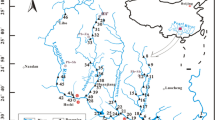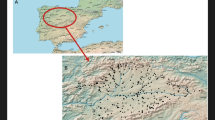Abstract
In this study, the Hg distributions in water and sediments from a mangrove creek that receives intensive shrimp farming effluents were determined. The average dissolved and particulate Hg concentrations in the water varied from 3.1 to 9.2 ng L−1 and from 4.4 to 9.4 ng L−1, respectively. However, the Hg concentrations in the suspended particulate matter and the bottom sediments varied from 95.4 to 115.7 ng g−1 and from 1.6 to 10.3 ng g−1, respectively. A Ward quadratic distance cluster analysis based on the Hg concentrations and hydro- and geochemical parameters (oxygen, salinity, temperature, pH, and organic matter and aluminum content) showed the effects of shrimp farming effluents on the Hg distribution pattern. Furthermore, these results were supported by the Hg distribution in the sediment cores. This study emphasizes the necessity of including Hg as a potential pollutant when monitoring the environmental impacts of intensive shrimp farming.




Similar content being viewed by others
References
Braga TMB (2006) Preliminary assessment of mercury contamination of fish commercialized at the Mucuripe Beach fish market and in the Jaguaribe River estuary, CE. Monografia de Graduação em Engenharia de Pesca, Fortaleza: Universidade Federal do Ceará, p 58. Avaliable at: http://www.institutomilenioestuarios.com.br/pdfs/Monografias/6_BragaTMB2006Contaminacao.pdf
Burford MA, Costanzo SD, Dennison WC, Jackson CJ, Jone AB, McKinnon AD, Preston NP, Trott LA (2003) A synthesis of dominant ecological processes in intensive shrimp ponds and adjacent coastal environments in NE Australia. Mar Pollut Bull 46:1456–1469
Dierberg FE, Kiattisimkul W (1996) Issues, inpacts, and implications of Shrimp Aquaculture in Thailand. Environ Manag 20:649–666
Dorea JG (2007) Fish meal in animal feed and human exposure to persistent bioaccumulative and toxic substances. J Food Prot 69:2777–2785
FAO – Food and Agriculture Organization of the United Nations (2010) The state of world fisheries and aquaculture, Rome, 218 pp
Gräslund S, Holmström K, Wahlström A (2003) A field survey of chemicals and biological products used in shrimp farming. Mar Pollut Bull 46:81–90
Lacerda LD, Santos JA, Madrid RM (2006) Copper emission factor from intensive shrimp aquaculture. Mar Pollut Bull 52:1823–1826
Lacerda LD, Santos JA, Lopes DV (2009) Fate of copper in intensive shrimp farms: bioaccumulation and deposition in pond sediments. Braz J Biol 69:851–858
Lacerda LD, Soares TM, Costa BGB, Godoy MDP (2011) Mercury emission factors from intensive shrimp aquaculture and their relative importance to the Jaguaribe River Estuary, NE Brazil. Bull Environ Cont Toxicol 87:657–661
Marins RV, Lacerda LD, Paraquetti HHM, Paiva EC, Villas Boas RC (1998) Geochemistry of mercury in sediments of a sub-tropical coastal lagoon, Sepetiba Bay, southeastern Brazil. Bull Environ Cont Toxicol 61:57–64
Marins RV, Paraquetti HH, Ayres GA (2002) Analytical alternative for the physical-chemical speciation of mercury in tropical coastal waters. Quím Nova 25:372–378
Paraquetti HHM, Ayres GA, Almeida MD, Molisani MM, Lacerda LD (2004) Mercury distribution, speciation and flux in the Sepetiba Bay tributaries, SE, Brasil. Water Res 38:1439–1448
Silva CAR, Rainbow PS, Smith BD (2003) Biomonitoring of trace metal contamination in mangrove-lined Brazilian coastal systems using oyster Crassostrea rhizophorae: comparative study of regions affected by oil, salt pond and shrimp farming activities. Hydrobiologia 501:199–206
Soares TCM, Coutinho DA, Lacerda LD, Moraes MO, Rebelo MF (2011) Mercury accumulation and metallothionein expression from aquafeeds by Litopenaeus vannamei Boone, 1931 under intensive aquaculture conditions. Braz J Biol 71:131–137
Vaisman AG, Marins RV, Lacerda LD (2005) Characterization of the mangrove oyster Crassostraea rhizophora, as a biomonitor for mercury in tropical estuarine systems. Bull Environ Cont Toxicol 73:582–588
Author information
Authors and Affiliations
Corresponding author
Rights and permissions
About this article
Cite this article
Costa, B.G.B., Soares, T.M., Torres, R.F. et al. Mercury Distribution in a Mangrove Tidal Creek Affected by Intensive Shrimp Farming. Bull Environ Contam Toxicol 90, 537–541 (2013). https://doi.org/10.1007/s00128-012-0957-4
Received:
Accepted:
Published:
Issue Date:
DOI: https://doi.org/10.1007/s00128-012-0957-4




